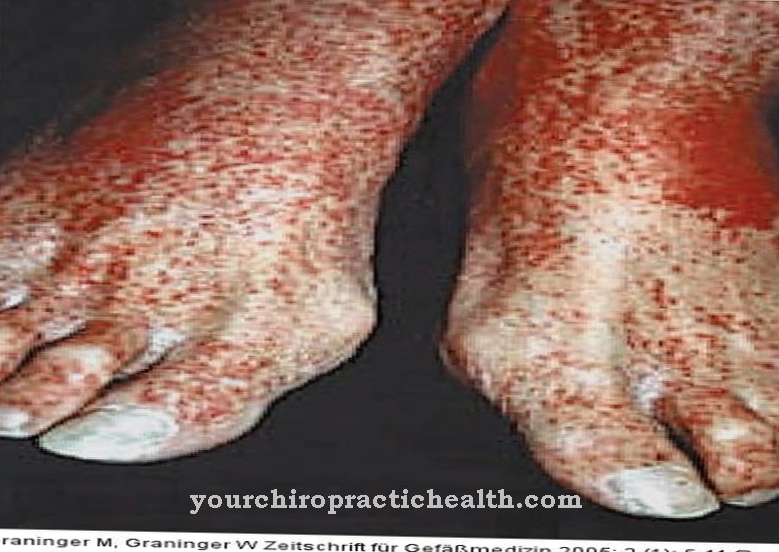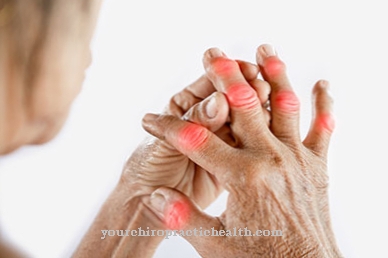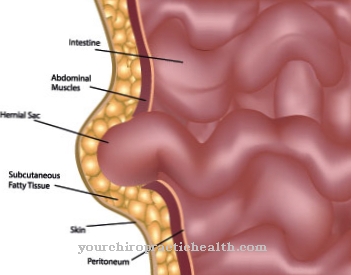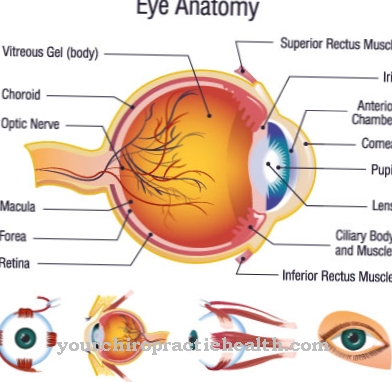The Gestosis is a pregnancy disease accompanied by high blood pressure. It occurs in various forms and its cause is still largely unknown. Gestosis should be treated as early as possible, otherwise it can lead to a life-threatening condition.
What is a gestosis?
.jpg)
© olenachukhil - stock.adobe.com
Gestosis is a disease that only occurs during pregnancy (Latin gestatio). One of the hallmarks of gestosis is increased blood pressure (hypertensive = blood pressure increasing).
Originally, all diseases that are triggered by pregnancy were referred to as gestoses and they were divided into early and late gestoses according to the time of their occurrence. Morning sickness belonged to the early gestosis, preeclampsia and high blood pressure to the late gestosis.
Today the term gestosis is used exclusively for diseases during pregnancy that cause high blood pressure. The different forms of gestosis are eclampsia and preeclampsia, high blood pressure, HELLP syndrome and graft clampsia.
The earlier term »EPH gestosis«, which was based on the symptoms of edema, increased protein excretion (proteinuria) and increased blood pressure (hypertension), is no longer common today.
causes
The exact triggers for a gestosis have not yet been clearly clarified. In the past, it was assumed that the body was poisoning, and gestoses were therefore also called pregnancy poisoning. However, this approach has not been confirmed.
Today it is believed that the uterus sends impulses to the body during pregnancy, which cause blood pressure to rise. However, there is still no reliable knowledge of what exactly triggers this process and how it works. It is assumed that the body is unable to adjust to the pregnancy and is overwhelmed by the various changes.
However, there are also some factors whose presence increases the risk of gestosis. These are, for example, various previous illnesses such as diabetes], kidney dysfunction or the antiphospholide syndrome. But pregnant women who are very overweight or older than 40 years also have an increased risk of gestosis.
Symptoms, ailments & signs
Symptoms of gestosis include high blood pressure, increased protein excretion in the urine, nausea, vomiting, headache, edema, seizures, pain in the right upper abdomen or visual disturbances. However, the gestosis can be divided into an early and a late gestosis.
Premature gestosis is usually harmless and occurs in the first trimester of pregnancy. It is mainly noticeable through nausea and vomiting and subsides again in the 12th week of pregnancy. After a gestosis-free period, a few women in the last third of pregnancy can develop a late gestosis with very severe symptoms.
Up to ten percent of pregnant women suffer from so-called preeclampsia, a late gestosis, which is characterized by increased protein concentrations in the urine, edema and greatly increased blood pressure. Preeclampsia can develop into what is known as eclampsia with life-threatening complications such as brain edema, thrombosis or acute kidney failure. Since the complications are life-threatening for both mother and child, immediate emergency medical help is required.
Gestosis cannot be cured during pregnancy. After the child is born, however, the symptoms subside. An even more severe form of preeclampsia is the so-called HELLP syndrome. The HELLP syndrome is characterized by severe pain in the upper abdomen as well as nausea and vomiting. In extreme cases, it can lead to death in a few hours. But here, too, the condition of mother and child quickly returns to normal after the birth.
Diagnosis & course
The typical symptom of gestosis is the increased blood pressure, which usually occurs after the 20th week of pregnancy. A gestosis is when the systolic value is higher than 140 mmHg and the diastolic value is higher than 90 mmHg in successive measurements.
With one-off measurements, a gestosis is suspected from a height of 160 mmHg. Usually there are other signs, such as increased excretion of protein (proteinuria) in the urine and water retention (edema) in the legs, feet, hands or face. One speaks of proteinuria when one liter of urine contains more than 300 mg of protein. In order to be able to measure this precisely, the pregnant woman has to collect the excreted urine over a period of 24 hours.
If the gestosis is not treated, it can lead to a life-threatening condition for mother and child. Eclampsia can occur with nausea and vomiting, stomach pain and headache, seizures and impaired consciousness.
To prevent such a severe course, an early diagnosis is important. At the first signs of high blood pressure, the doctor should measure the protein concentration in the urine and conduct a comprehensive blood test. Other possible examinations are sonography (ultrasound) and cardiotocography (CTG, recording of the child's heartbeat).
Complications
The most common complication of a hypertensive pregnancy disorder that is not recognized or treated too late is premature birth - even if this can be averted, in some cases growth disorders or liver and kidney damage can occur in the unborn child. A severe form of gestosis - also called eclampsia - causes seizures, which can cause the placenta to separate.
In this case, the lives of mother and child are in acute danger. Other possible consequences are acute kidney failure, cerebral edema, thrombosis or heavy bleeding. A lack of oxygen during a seizure can impair the mother's brain function and lead to coma or death. The HELLP syndrome is a rare but also life-threatening complication of gestosis for mother and child: When the liver function declines, the liver values in the blood rise sharply and blood clotting deteriorates.
HELLP syndrome can develop within a few hours and manifests itself as severe pain in the upper abdomen, which is often accompanied by nausea and visual disturbances. If the pregnancy is not ended quickly by a caesarean section, a rupture of the liver, cerebral haemorrhage or the detachment of the placenta can result. A gestosis that has been overcome increases the risk of recurring complications in a subsequent pregnancy.
When should you go to the doctor?
Pregnant women should always take part in the check-ups and preventive examinations offered during pregnancy. To ensure the health of mother and child and to check the development process, it is advisable to use the available offer. If the expectant mother has the vague feeling of an anomaly or abnormality, it is recommended to make an appointment with a doctor.
If the heart palpitations, if the blood pressure is increased or if the internal body heat rises abnormally, a doctor's visit is required. In the event of seizures or severe pain, an emergency doctor should be called. Until it arrives, the instructions and advice of the emergency services must be followed. An emergency doctor is also needed if there is a disturbance of consciousness or loss of consciousness. If you feel faint, the pregnant woman should sit down immediately and then call the emergency services.
If the expectant mother suffers from unusually strong water retention in her legs, hands or face, she should consult a doctor. If these increase significantly so that locomotion is impaired or emotional problems arise due to the visual flaw, a doctor's visit is necessary. If irregularities can be noticed when urinating, a doctor should also be consulted.
Doctors & therapists in your area
Treatment & Therapy
The therapy of a gestosis depends on its severity and any illnesses the pregnant woman may have. In the early stages and with mild symptoms, bed rest and rest can often help. The primary goal of treatment is to prevent life-threatening eclampsia.
In order to lower the blood pressure, antihypertensive drugs are usually administered, but these are only used when the values are above 170/110 mmHg. To prevent proteinuria, the pregnant woman has to consume more protein. Magnesium sulfate is prescribed to prevent possible seizures.
Bed rest should be observed in any case. If the symptoms are already advanced, the patient is usually admitted to the clinic so that she can be permanently monitored.
A permanent bladder catheter is often placed in the hospital, with which the urine output can be checked, and a permanent blood pressure meter is installed that records the measured values at certain short time intervals. In very severe cases of gestosis, early delivery by caesarean section may be required.
Outlook & forecast
Gestoses are especially an issue in the first and last trimester of pregnancy. The second trimester, the so-called tolerance stage, is often very calm and without gestures. During the first trimester, however, they can put the pregnancy as a whole at risk if they are particularly severe. In the last third, in the worst case, they lead to the premature birth of a premature baby who needs medical support in its first few weeks of life.
In the meantime, most gestoses are recognized early on on the one hand by prenatal care and on the other hand there are effective treatment options so that the risks for mother and child can be kept low and the pregnant woman does not suffer unnecessarily. A distinction must be made between gestoses and so-called graft gestoses. The latter was a disease that existed before pregnancy and its symptoms have now been exacerbated by it.
If the woman was treated with medication for an underlying disease before the pregnancy, the active ingredient or dose may have to be adjusted, because not all medicines and active ingredients are suitable for pregnant women. Gestoses usually recede quickly after the child is born, as soon as the woman's hormone balance returns to normal. Some go away after a few weeks, for example morning sickness at the beginning of a pregnancy.
prevention
Gestosis can be successfully prevented if regular check-ups are carried out right from the start in the case of existing diseases or factors that represent an increased risk. If a gestosis is detected early, it can be treated more easily and reliably.
Aftercare
With gestosis, the options for follow-up care are severely limited in most cases. The focus is on the early detection and treatment of this disease in order to prevent further complications. If the gestosis is recognized or treated late in the process, in the worst case scenario it can lead to the death of the mother and the child.
In most cases, the disease is treated with medication designed to lower the person's blood pressure. These medications should therefore also be taken correctly and regularly in order to completely relieve these symptoms. The patient should also check her blood pressure regularly during the gestosis. If in doubt, it is advisable to consult a doctor.
Furthermore, those affected are dependent on strict bed rest. Exertion or other stressful activities should be avoided in order to accelerate healing. Regular checks by the doctor are also useful in order to regularly check the child's condition.
If the gestosis is detected and treated early, there are usually no further complications or complaints and therefore no change in life expectancy for the mother or child. In some cases, however, people need a caesarean section.
You can do that yourself
If a gestosis was found, the woman concerned must take care of herself. Especially in the early stages, bed rest and relaxation help relieve symptoms and prevent eclampsia. In addition to using medication, moderate exercise, a change in diet and stress avoidance are recommended to lower blood pressure. A protein-rich diet is recommended against proteinuria.
Seizures can be avoided by taking magnesium supplements. Alternatively, preparations from homeopathy can be tested, for example Schüßler salts or the preparation Cuprum metallicum 200C. Before using alternative agents, however, you should speak to your doctor. At the same time, the body must not be strained excessively.
If the gestosis is advanced, the patient must go to a hospital. In most cases, permanent monitoring is then necessary. For most women, gestosis also represents a great psychological burden. That is why therapeutic help should be sought after the end of pregnancy in order to deal with the difficult phase of life. Some women also benefit from contact with other affected persons. The doctor in charge can answer which options are available for self-help groups and the like.



.jpg)

.jpg)






.jpg)



.jpg)










.jpg)
